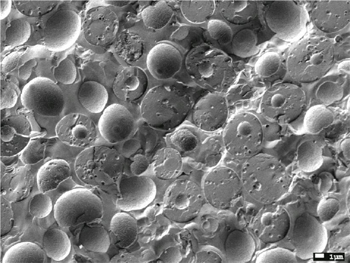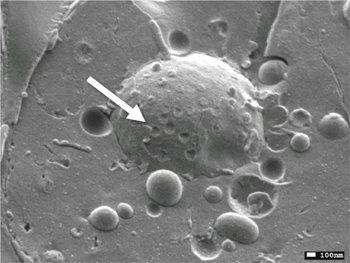Observation of Bread Yeast with Cryo-SEM
SM063
Using Cryo-SEM, a hydrated specimen, which is rapidly frozen by slush nitrogen in the air, can be imaged while keeping the ‘natural’ state of the specimen. This avoids dehydration of the specimen that can lead to distortion of the surface structures. It also allows imaging of oils and other components that are not observable at room temperature under vacuum. As an observation example, cryo-SEM of bread yeast is presented below.
Observation of bread yeast
A specimen was dehydrated yeast which was returned to its original state by water. The yeast specimen, rapidly frozen by slush nitrogen, was loaded into the specimen preparation chamber using an airlock chamber and freeze-fractured. Etching was aplied to the specimen at -90˚C for 5 minutes, before coating with platinum for SEM observation. The use of a Schottky field emission scanning electron microscope enables acquisition of high magnification images, even at a low accelerating voltage of 1.5 kV. The freshly fractured surfaces and cross sections of the yeast at medium magnifications were observed (left image). In addition, at highe rmagnifications, the fine structures of nuclear pores (indicated by the arrow) were clearly seen (right image).

Accelerating voltage: 1.5 kV, Magnification: x3,000

Accelerating voltage: 1.5 kV, Magnification: x30,000
- Please see the PDF file for the additional information.
Another window opens when you click. 
PDF 287KB
Related Products
Are you a medical professional or personnel engaged in medical care?
No
Please be reminded that these pages are not intended to provide the general public with information about the products.
